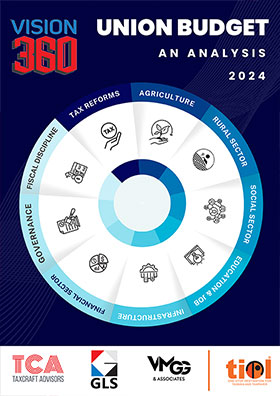TIOL - COB( WEB) - 513
AUGUST 11, 2016
By Shailendra Kumar, Editor
History was indeed made when the Rajya Sabha passed the GST Bill after a marathon debate. Some of the erudite Members of the House truly made the debate highly enriching, intellectually. One of the contentious demands of the Opposition was that whenever the bills relating to GST laws are tabled, they should not be Money Bills. The Union Finance Minister, Mr Arun Jaitley, smartly 'ring-fenced' himself by saying that it would largely depend on the content of the Bill. Given the fact that the GST legislations - the CGST and the ISGT, which are going to be legislated by the Parliament, are going to substitute the Central Excise Act, the Finance Act, 1994 and the CST Act, all relating to tax laws including the tax rates, the dominant character of the bills would be the Money Bill. Even if some parts of them may bear some nexus with non-Money Bill, the Speaker of the Lok Sabha would have no option but to tag them as Money Bills. Once they are discussed and debated as Money Bills, the Council of States (the Rajya Sabha) would lose its say to amend them or vote against them. Given the history of precedents and the content of the Model GST laws (refined laws would further tilt them in favour of money bills), the character of the twin bills is quite predictable, and the fear of the opposition parties is bound to come true! But they need not find fault with the intent of the Government. If they do, it would be avoidable politics to delay the inevitable. And it may earn some brownie points for the Government rather than the Opposition which would be trying hard to score well in the assembly polls in the five states which are scheduled to go to the husting's next year.
Let's now move towards what is in store for the taxpayers? With this Constitutional Amendment one thing which has become certain is that the GST is going to come. The only question which may be highly debatable is - whether it would be a blessing or a curse for the economy? Theoretically speaking, it has the potential and the intrinsic characteristics to 'shape into' a blessing provided it is 'fleshed out' intelligently and diligently by the supporting sub-systems such as moderate tax rate; minimum exemption; high exemption threshold; neatly-defined definitions of key phraseologies; minimal and clear-cut classification; simple valuation rules; seamless credit chain; neat and clean procedures for registration, tax payment, return-filing and many more. Anything contrary to these features would be a humungous curse for the economy. In other words, if not treaded carefully, it may turn out to be a double-edged sword - neither doing any good to the economy nor to the exchequer's interests.
Let's go to the STARTING POINT for some brief comments. Unlike other economies, the Indian GST model is going to begin its journey by excluding several key commodities such as petroleum, alcohol for human consumption, tobacco, electricity and real estate. This means a large chunk of the economy is out, and would continue to 'distort' the CREDIT CHAIN which happens to be the soul of the GST system. So, our journey actually begins with a half-cooked GST model. What has further 'crippled' it is our decision to not subsume the local bodies taxes. What have been deleted from the State List by the Constitutional Amendment Bill are only the Sales Tax, Entry Tax and Entertainment Tax. It is very clear that although Entry 52 has been omitted but the power of the local bodies such as municipal corporations, district councils and panchayats to levy taxes has not been tinkered with. In other words, all such Entry Taxes which are imposed by the States would go away but not the taxes collected by the municipalities. And one such big irritant is the Octroi which generates as much as Rs 7000 Crore revenue annually for Brihanmumbai Municipal Corporation (BMC). So, the verdict is out - the industry and trade cannot escape from the curse of chungis / nakas at entry points, totally. Similar nakas are going to be omnipresent across the country as most State Governments would be allowing the municipalities to generate revenue for themselves rather than sharing their revenue with them.
Another flaw which may result in long queues of trucks at nakas is going to be the list of exempted goods. The actual virtue lies in a shortest possible list of exempted items. Some countries have opted for no exemption but direct transfer of subsidy to the accounts of poor people who need to be supported by the State. One good example is Malaysia. But, can India do it? No doubt, the NDA Government has begun an experiment to directly transfer cash subsidy in the bank accounts of the target groups but are we statistically and technologically ready for such exercise even for the GST subsidy? Perhaps, NO. In this case, our list of exempted items is going to be long, and States are not going to spare them from physical verification at nakas.
If our exemption list, even after pruning the present lists of the Central Government and the States, is going to be long, it would jack up the Revenue Neutral Rate (RNR) which is yet to be worked out. Indecision over the list of exempted items, exemption threshold and band for tax rates to be allowed to the States, was the sole reason which compelled Mr Arun Jaitley to be non-committal on the GST rate of 18% which the Opposition has been demanding. Going by the Centre's commitment for 100% revenue compensation to the States and a number of CESSES imposed by the Centre, he is quite right to indicate that the tax rate may be higher than 18%. A higher rate may be Mr Jaitley's compulsion but it would further compromise the curtailed efficiency of the half-cooked GST.
In this background of severe limitations and multiple distortions, a mandatory caution which must not be abandoned by the Centre and the States, is that whatever laws they are going to legislate, they must be LIBERAL for better compliance and their legal terminologies should be neatly defined. The fact that the Ministry of Finance has got flooded with representations from the industry and trade about the flaws in the Model GST Laws (about 40,000 as per the Revenue Secretary), is a clear indication that there is an urgent need to revisit the key concepts such as what constitutes SUPPLY and TIME and PLACE of Supply; valuation, credit, jobwork and classification. I am sure out of tonnes of representations, a large chunk may not be of any import or value but some of them would certainly warrant a revisit. And any decision to revisit should begin by calling for a Concept Paper on Supply by each official who is going to work on the final piece of the GST legislation. The definition of supply is going to be the most critical piece which would determine other important phraseologies. Once it is finalised, a White Paper should be released for public feedback before other key concepts are fleshed out.
No doubt, such an exercise is going to delay the roll out of the proposed GST. But, our law makers and the political leadership should not forget that whatever laws they are going to flesh out, they are going to be around for more than 100 years. When our political leadership does understand that the proposed GST has the potential to add more than one per cent to the GDP growth rate, it can add only if it is neatly, cleanly and liberally designed. If its strength is going to be higher compliance index and large tax base, it would happen only if it is easy to understand and comply with. So, designing an easy and liberal law does warrant the luxury of time. The traditional wisdom is that when a new legal edifice is being built, it need not be rushed into. There is nothing sacrosanct about April 1, 2017. India has taken 10 years to overcome the first major milestone of Constitutional Amendment. There is no harm even we take another three years to draft a conceptually clean model law and then give enough time to the industry and trade, including small businesses, to prepare themselves for the new indirect tax system. Once all the unknowns are finalised by the GST Council and a roll-out time of 12 months is given to the assessees, India can avoid inevitable consequences of fiscal mess, revenue loss, distortions in the economy and inflationary pressure on the common man.
But, going by the preparations in the North Block, it appears that the new GST laws are going to retain almost 75% of what is today in the public domain. Only about 25% changes may be effected. This clearly means that our law makers and the political leadership are too keen to embrace the predictable chaos which would follow from too many distortions commented upon so far. Even if it is not going to be April 1, 2017, the deadline in their mind is perhaps October 1, 2017. Even this deadline is not realistic if the GST Rules are going to be notified by early next year, and the GST Network is going to run its pilots early next year. Let's not forget that the proposed GST is going to be a totally IT-driven tax system where not less than 400-500 crore invoices are going to be uploaded and matched like the Income Tax TDS system before any tax credit is allowed. When the task is so gigantic, the most valuable input to efficiently execute such a task is often the TIME which appears in short SUPPLY here. If time itself is not 'supplied' in proper quantum, one may well imagine what is going to be the fate of 'SUPPLY' under the GST! |









 Download PDF
Download PDF




